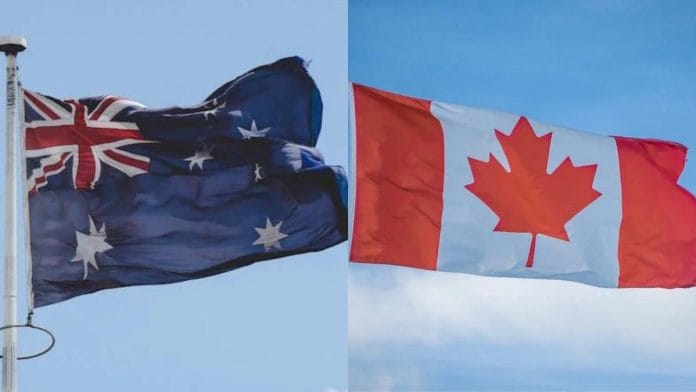New Delhi: Australia announced Tuesday that it plans to limit its foreign students intake to 2,70,000 for the year 2025, in a bid to rein in record levels of migration that have increased house rental prices. The move is set to have a considerable impact on Indian students going abroad for higher education, especially those from Punjab, which accounts for a large number of such students.
A day earlier, the Canadian government in a similar vein announced its reduction of the number of Temporary Foreign Workers (TFW) allowed into the country after record levels of migration fuelled an unemployment and housing crisis in the country.
“Today the government has announced that, subject to the passage of legislation before the Parliament, it will set a National Planning Level (NPL) for new international student commencements of 270,000 for calendar year 2025,” said the Australian Ministry of Education in a press statement.
“For publicly funded universities, the managed growth approach, in aggregate, will result in around 145,000 new international student commencements in 2025, which is around 2023 levels,” it added.
Other universities will be limited to around 30,000 new international students, while the remaining 95,000 students will be allowed to study at vocational education and training institutions.
According to the Indian Ministry of External Affairs, around 1.22 lakh students from the country study in Australia. India’s Quad partner is the fourth most popular destination for Indian students studying abroad, following Canada, the US and the UK.
In the last decade, the contribution of the international education sector to the Australian economy has grown tremendously, to A$36.4 billion in 2022-2023 from A$16.9 billion in 2014-2015.
In July this year, the Australian government more than doubled the non-refundable visa fee for foreign students from A$710 to A$1,600 in a further bid to reduce net migration levels from 5,28,000 in 2022-2023 to 2,60,000 by 2024-2025.
Caps on university intake of international students has been the focus of the Labor government in Australia, with plans first announced in December 2023 to tighten student visa rules and low-skilled workers to halve migration numbers by 2025.
Earlier this month, ThePrint had reported that visa applicants from Punjab, Gujarat and Haryana seeking to pursue higher studies in countries like Canada and Australia are facing higher rates of rejection amid tightened rules. The Australian High Commission in India had told ThePrint at the time that the idea behind such rules is to “restore integrity” in their education sector through “increased scrutiny of the caseload”.
Also Read: Indian spies ‘kicked out’ of Australia for trying to steal defence secrets — ABC News report
Canada tightens temporary foreign workers’ visas
Canada, another country that has focused on migrant labour during the post-COVID era to solve a labour shortage, Monday announced the reduction of the temporary foreign worker visa programme.
Prime Minister Justin Trudeau announced the move in a post on X.
We’re reducing the number of low-wage, temporary foreign workers in Canada.
The labour market has changed. Now is the time for our businesses to invest in Canadian workers and youth.
— Justin Trudeau (@JustinTrudeau) August 26, 2024
The unemployment rate in Canada has surged to 6.4 percent following consecutive monthly increases in May and June this year. The unemployment rate, between April 2023 and June this year, has grown 1.3 per cent, according to data released by the Canadian government.
Canada is the top destination for Indian students according to the Ministry of External Affairs, with roughly 4,27,000 Indians studying in the North American country. The low-wage TFW programme saw 83,654 such workers living in the country in 2023, according to Canadian media reports.
“The Temporary Foreign Worker program was designed to address labour market shortages when qualified Canadians were not able to fill those roles. Right now, we know that there are more Canadians qualified to fill open positions. The changes we are making today will prioritise Canadians workers and ensure Canadians can trust the program is meeting the needs of our economy,” Randy Boissonnault, the Minister of Employment, Workforce Development and Official Languages said in a statement to the media Monday.
On 20 August, the Canadian government approved a request from the government of Quebec to temporarily freeze the TFW programme in the city of Montreal.
Under the new limits, a company will be able to hire no more than 10 percent of its total workforce through the TFW programme, down from the 20 percent cap that earlier existed. Furthermore, in metropolitan areas where the unemployment rate is above 6 percent, the government will not allow companies to hire foreign workers.
According to Canada’s national statistical agency Statistics Canada, the number of non-permanent residents in Canada, which includes students, asylum seekers and temporary foreign workers rose to 2.8 million this year from 1.3 million in 2021.
Of the 2.8 million non-permanent residents, around 1.3 million people hold work permits according to Canadian government data. A United Nations report published earlier this month compared Canada’s TFW programme to forms of “contemporary slavery”.
(Edited by Gitanjali Das)
Also Read: ‘Double standards’ — India hits out at Canada over ‘lack of action’ on ‘anti-India’ elements







Hardly anyone from Punjab goes to Canada for genuine higher studies. An overwhelming majority abuse the Canadian student visa and engage in illegal activities. The Canadian authorities, in order to keep the Khalistani votebank in good humour, turn a blind eye.